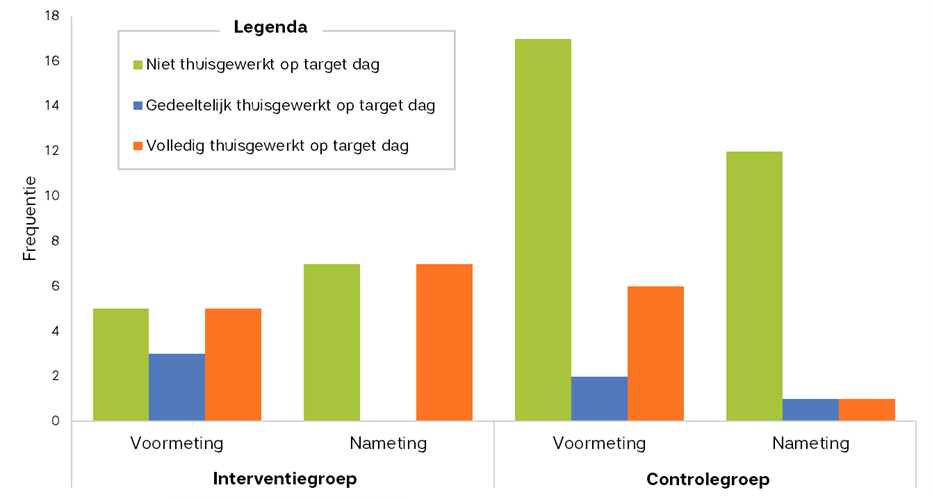
The Psychology of Working from Home: Results from the Work from Home Email
In an earlier article, Eline Verhoeven, master student in behavioral change, shared her findings on the psychology behind working from home. In the approach to parking, office and traffic congestion. The literature study showed a connection between various psychological factors and working from home behavior. In a practical study, we tested a behavioral solution that played on these psychological factors. In this article, Eline shares the results.
Many people often work from home on the same days and at the office on Tuesdays and Thursdays. This leads to peak traffic on the road and in the office on these days. Despite the motivation to change this, it is not happening enough yet. That is why we developed and evaluated a behavioral solution for employers in the practical research to better spread working from home over the week and thus make better use of office and parking capacity. This was tested with employees with a job that can be performed from home, which gave us more insight through trial and error into what works and what does not in spreading working from home.
What was investigated?
The literature review showed that several psychological factors influence teleworking. A strong intention to work from home and a sense of control over the teleworking process were related to more hours worked from home. Positive norms about teleworking among colleagues at work also promoted the number of hours worked from home. A strong habit of commuting to the office was related to fewer hours worked from home.
To apply these findings in a solution, the 'work from home email' was developed. An email in which employees were encouraged to participate in the Work from Home Tuesday or Work from Home Thursday, signed by their team leader. The email also contained tips and an Outlook appointment invitation for the relevant work from home day, including reminder notifications. We then examined this email for its effectiveness: can the work from home email help increase the number of home workers on Tuesday/Thursday?
This is what the work-from-home email looked like (the front):

In the week of the home-work email, employees received the home-work email. We looked at whether this email influenced the scores on these psychological factors. We also looked at whether the email influenced working from home on a specific workday.
To investigate this, we compared a group of people who had received the home-work email (the intervention group) with a group of employees who did not receive the home-work email (the control group). The study had the following research design:

What were the main findings?
Important: This study had a very small sample size, which means that we have to interpret the findings with caution. It is possible that this study shows an effect that does not really exist in reality, and vice versa. We are therefore cautious in the statements we make in this advisory report.
- The work-from-home email had no impact on working from home on the specific working day: there was no change between the pre- and post-measurement in the share of working from home among people who had received the work-from-home email, compared to the group that had not received it.

- The work-from-home email had no effect on psychological factors: there was no change in intention to work from home, travel habits, norms and perceived control over working from home between pre- and post-measurement in the group that received the email.
- Working from home and norms about working from home differ between groups, but not through the work-from-home email: the intervention group had worked from home more and had stronger perceived norms about working from home, compared to the control group. This indicates selection bias: the intervention group differed systematically from the control group in character, which was not caused by the intervention.
- Resistance: despite the fact that the work-from-home email emphasized that the work-from-home day without obligation and you did not have to participate, the open answers showed that there was resistance to the request and the way in which the request was made. The home work email also received a negative rating.
Conclusion?
The literature study showed that working from home is explained by various psychological factors. However, the practical research could not demonstrate that the home work email, aimed at these factors, resulted in more working from home. The practical research therefore does not provide evidence for the effectiveness of the home work email. It is possible that an intervention on team level better to organize a joint work-from-home day.3 However, we must be cautious in the statements we make, due to the small sample size of the email examined.
The results do show the importance of recognizing resistance to change. When developing and researching home-working emails, it is crucial to take this resistance into account. Although travel habits play a role, working from home is primarily a conscious choice that is not made “just like that”: employees make a well-considered decision whether or not to work from home on a particular day. Therefore, take employees seriously: listen to needs, motives and values1 and involve them in implementing and organizing the change.2
In order to be able to draw more reliable conclusions about the effectiveness of the current intervention, similar research is still ongoing with a larger research group. We are curious to see what will come of it.
Read Eline's other articles
Do you want to keep Brainport accessible? Join us. We would be happy to discuss this with you. To work on opportunities, innovations and solutions. Because we can only do that together. Contact us at info@brainportbereikbaar.nl.
